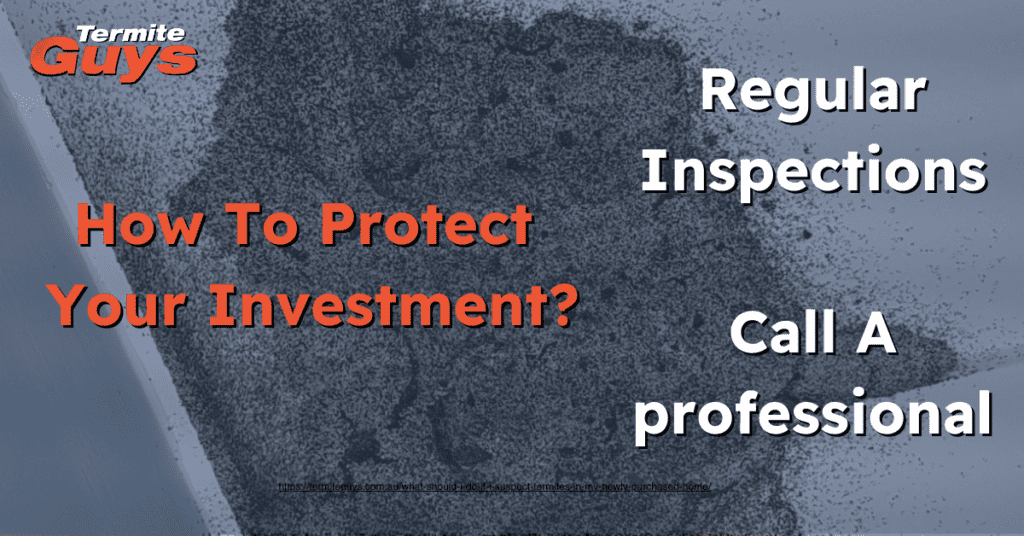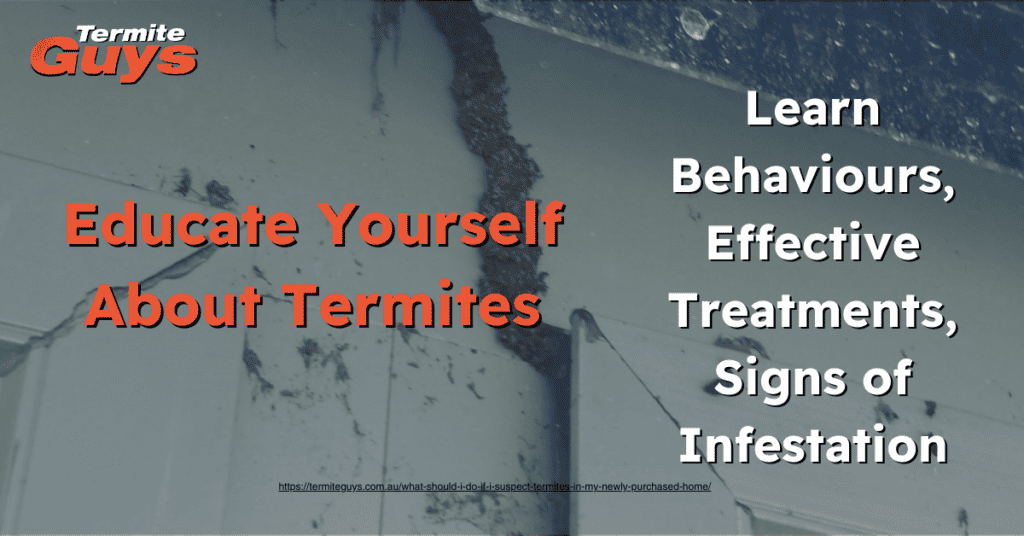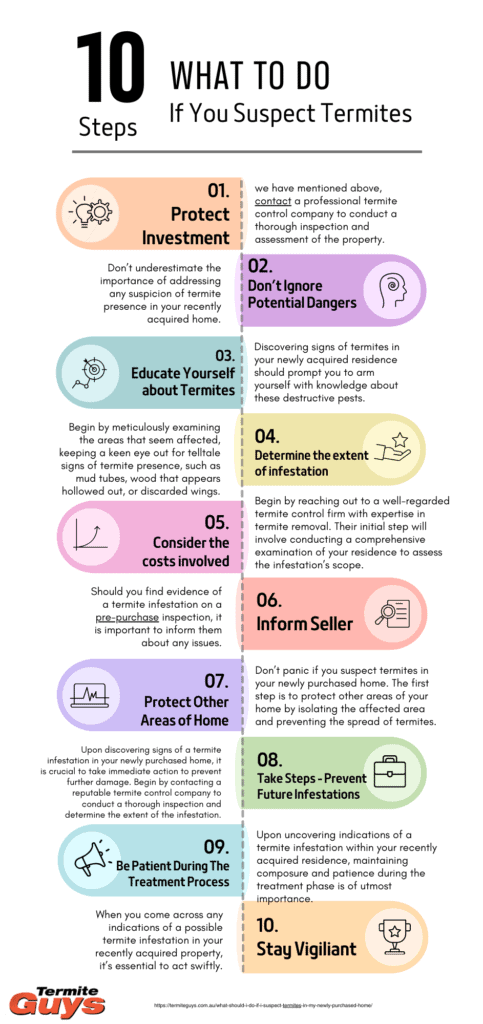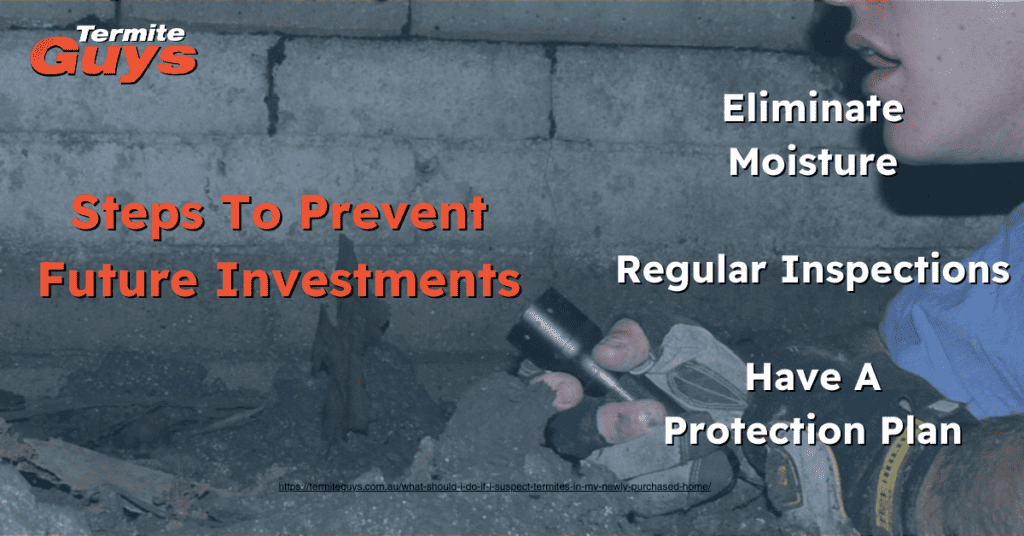If you suspect termites in your newly purchased home, it is important to take immediate action to prevent any further damage. First, conduct a thorough inspection of the property, paying close attention to areas where termites are most likely to be found, such as the subfloor, crawl spaces, and around wooden structures. Look for signs of termite activity, including mud tubes (termite shelter tubes), discarded wings, or wood that sounds hollow when tapped.
If you find evidence of termites, it is recommended to consult with a professional termite control company that specializes in termite treatment. They will be able to assess the extent of the infestation and recommend appropriate treatment options. Additionally, it is important to address any moisture issues in your home, as termites are attracted to damp environments. Make sure that the property is well-ventilated and address any leaks or water damage promptly.
Finally, consider investing in a termite protection system to prevent future infestations. These systems typically involve regular inspections and treatments as needed. By taking prompt action and following these preventative measures, you can protect your investment and ensure the long-term integrity of your newly purchased home.
To assist you in protecting your newly purchased home here are 10 action steps to take if you suspect termites on the property.
1: Protect your investment immediately!

If you suspect termites in your newly purchased home, take immediate action to protect your investment. Firstly as we have mentioned above, contact a professional termite control company to conduct a thorough inspection and assessment of the property. They have the expertise and tools to identify the presence of termites and determine the extent of the infestation. Next, follow their recommendations for treatment, which may include the use of chemical barriers or baiting systems to eliminate the termites. Taking prompt action is crucial to prevent further damage to your home and minimize costly repairs.
Additionally, educate yourself about termite prevention measures to avoid future infestations. These include maintaining proper drainage around the foundation of your home, keeping firewood and other wooden materials away from the house, and regularly checking for signs of termites such as mud tubes or discarded wings. It is also important to schedule regular termite inspections to catch any potential issues early on. By being proactive and taking preventive measures, you can protect your investment and ensure the long-term stability and value of your newly purchased home.
1A: Inspect for signs of termites.
Inspect your property today to safeguard your investment against potential damage caused by termites. These destructive pests can wreak havoc on the structure of your home, leading to costly repairs and decreased property value. By conducting regular inspections, you can identify early signs of termite infestation such as mud tubes, wood damage, or discarded wings. If any indicators are discovered, it is crucial to contact a professional pest control company immediately to implement effective termite treatment and protect your investment from further deterioration. Don’t delay, take action now to ensure the long-term integrity of your property.
1B: Contact a professional Termite Guy.
Hiring a professional company that specialises in termites is essential to protect your investment and ensure the safety of your property. A skilled Termite Specialist will have the knowledge and expertise to identify and eliminate any pests or infestations that may be present. They will use industry-approved methods and treatments to effectively eradicate the problem and prevent future occurrences. By contacting Termite Guys™, you can have peace of mind knowing that your investment is being protected and that your property is being kept in optimal condition. Don’t wait until the problem worsens, take immediate action and reach out to a trusted professional today.
1C: Take preventative measures for future infestations.
Protecting your investment is crucial for ensuring its long-term value. By taking preventative measures against potential infestations, you can avoid costly damages and preserve the integrity of your investment. Implementing proper pest control strategies, such as regular inspections and treatments, can help guard against the destructive effects of pests. Additionally, constructing buildings with termite-resistant materials can significantly reduce the risk of structural damage. By prioritizing preventative measures, you can protect your investment and maintain its value for years to come.
2. Don’t ignore potential dangers.
Don’t underestimate the importance of addressing any suspicion of termite presence in your recently acquired home. Termites have the potential to wreak havoc on your house’s structural integrity, which could result in expensive repairs down the road. It’s vital to act promptly by reaching out to a termite control expert with expertise in termite removal. They will perform a comprehensive evaluation of your property, pinpoint any indications of termite infestation, and devise a personalized strategy for eradicating the issue.
In the meantime, avoid any DIY termite control methods as they may be ineffective and cause further damage. It is also important to minimize the conditions that attract termites, such as moisture and wood-to-ground contact. Keep the area around your home dry and well-ventilated, fix any leaks or water damage promptly, and consider using termite-resistant materials for construction and landscaping. Remember, acting swiftly and seeking professional assistance is crucial in tackling a potential termite infestation and protecting your investment.
2A: Understand the risks associated with termites.
Understand the risks associated with termites and take action to protect your home. Termites can cause extensive damage to the structure of your house, weakening the foundation and compromising its integrity. These pests are known for their ability to silently destroy wood and other cellulose-based materials, making them a serious threat to the stability of your property. Ignoring the presence of termites can lead to costly repairs and potential safety hazards. By being proactive and implementing preventative measures, such as regular inspections and treatment, you can avoid the devastating consequences of a termite infestation. Protect your investment and ensure the long-term durability of your home by addressing the risks posed by termites.
2B: Recognize the damage they can cause.
Termites, commonly known as “silent destroyers,” have the ability to cause extensive damage to homes and structures. These tiny pests feed on wood and cellulose materials, including furniture, books, and even insulation. Oftentimes, termites go unnoticed until significant damage has already been done, making prevention and early detection crucial. Infestations can weaken the structural integrity of buildings, leading to costly repairs and potential safety hazards. It is important for homeowners and property owners to be aware of the signs of termite infestations, such as mud tubes, discarded wings, and hollow-sounding wood, to mitigate the risk of extensive damage by termites.
2C: Take action promptly to minimize harm.
Don’t dismiss the potential hazards that come with having termites in your home. Take immediate action to minimize any potential damage. Termites can quickly cause structural damage to your home, compromising its integrity and value. By addressing the issue promptly, you can prevent further destruction and save yourself from costly repairs. Don’t delay in seeking professional help to eliminate these pests and protect your property.
3. Educate yourself about termites!

Discovering signs of termites in your newly acquired residence should prompt you to arm yourself with knowledge about these destructive pests. Termites, as wood-destroying insects, have the potential to inflict substantial harm on your home’s structural integrity if their presence is not addressed promptly. These relentless creatures subsist on cellulose, primarily present in wood, and can swiftly infiltrate and undermine your home’s structure. Equipping yourself with information about the indicators of termite infestations and gaining insight into the essential measures for prevention and eradication will empower you to safeguard your investment and secure the wellbeing of your home.
Some of the common signs of termite infestation include mud tubes on the exterior walls, visible swarms of winged termites, and hollow-sounding wood. Additionally, you may notice discarded wings near windowsills or in other areas of your home. If you suspect termites, it is essential to contact a professional Termite control company to conduct a thorough inspection and assessment of the situation. They will be able to identify if there is an infestation and recommend the appropriate treatment plan. Taking immediate action is crucial to prevent further damage and the potential spread of termites to other areas of your home.
3A: Learn about their behaviour and habits.
Termites are social insects that live in colonies and feed on wood. They play an important role in the ecosystem by breaking down dead plant material and recycling nutrients back into the soil. Termites communicate through pheromones and can cause significant damage to buildings and wooden structures. They are known for their ability to construct intricate tunnels and mud tubes, which they use for protection and accessing food sources. It is important to educate yourself about termite behaviour and habits to prevent infestations and minimize damage to your property. Take proactive measures such as regular inspections, maintaining proper ventilation, and removing sources of moisture to deter termites from invading your home.
3B: Familiarize yourself with common signs of infestation.
Get familiar with the telltale signs of a termite infestation. Look for discarded wings near windows and doors, as termites shed their wings after swarming. Notice if there are any small holes or tunnels in wooden structures, as termites create these as they burrow through the wood. Keep an eye out for mud tubes along the foundation of your home, as these are pathways that termites use to travel. Also, check for frass, which is termite droppings that resemble small piles of sawdust. By recognizing these signs, you can take proactive measures to protect your property from further damage.
3C: Gain knowledge on effective treatment options.
Termites can cause significant damage to your home, so it’s crucial to educate yourself about effective treatment options. With over 2,700 species of termites in the world, it’s important to understand their behaviour and habits to effectively eliminate them. By learning about the different types of termites, such as subterranean, drywood, and dampwood termites, you can identify the most suitable treatment methods. Some common treatment options include liquid termiticides, baits, and physical barriers, each having its own advantages and disadvantages. It’s also essential to consider factors like the extent of the infestation, the size of the affected area, and the construction of your home when choosing the most effective treatment approach. Consulting with a professional Termite control expert can provide you with valuable insights and recommendations based on their experience and expertise.
4. Determine the extent of infestation!
When it comes to dealing with a potential termite issue in your recently acquired property, the initial course of action revolves around gauging the scope of the infestation. Begin by meticulously examining the areas that seem affected, keeping a keen eye out for telltale signs of termite presence, such as mud tubes, wood that appears hollowed out, or discarded wings. An additional tip is to gently tap on wooden surfaces and listen for a hollow sound, which may suggest termite damage. For a more comprehensive assessment, it’s strongly advisable to enlist the services of a professional termite control expert. Their knowledge and specialized tools ensure the detection of even the most subtle traces of termite activity.
Once the extent of the infestation is determined, it is important to take swift action to prevent further damage. Depending on the severity of the infestation, treatment options may vary. Options can include liquid termiticides applied around the perimeter of the home, termite baits placed strategically to eliminate the colony, or heat treatments that effectively kill termites in the affected areas. It is crucial to consult with a reputable termite control company to determine the best course of action based on your specific situation. Remember, early detection and prompt treatment are critical in minimizing the potential damage caused by termites.
4A: Assess the severity of the termite problem.
To accurately assess the severity of a termite infestation, it is crucial to determine the extent of the problem. Undertaking a thorough inspection of the affected area is essential in identifying the scope of the infestation. Careful examination of visible signs such as discarded wings, mud tubes, and damaged wood can provide valuable insight into the level of termite activity. Additionally, utilizing specialized equipment like thermal imaging cameras and moisture meters can aid in detecting hidden termite colonies and areas of high moisture, which are ideal breeding grounds for these pests. By gathering comprehensive information on the extent of the infestation, homeowners and termite control professionals can develop effective strategies for eradication and prevention.
4B: Identify affected areas in your home.
To determine the extent of infestation in your home, start by conducting a thorough inspection of all areas. Begin with commonly affected places such as the subfloor, roof space, and crawl spaces. Look for signs of pests including droppings, chewed wires, and gnaw marks on furniture. Pay close attention to cracks and crevices where pests can enter and hide. Additionally, inspect areas where moisture is present such as bathrooms and kitchens, as pests are often attracted to damp environments. By carefully examining these areas, you can identify the extent of the infestation and take appropriate measures to eliminate pests from your home.
4C: Gauge the urgency of treatment required.
To accurately assess the severity of an infestation, it is crucial to conduct a comprehensive inspection of the affected area. By thoroughly examining the space and identifying any visible signs of pests, such as droppings, nests, or damage to structures, professionals can determine the extent of the problem. Additionally, the use of advanced detection methods, like thermal imaging or pest-sniffing dogs, can provide valuable insights into hidden infestations. This thorough evaluation allows for a more accurate assessment of the urgency for treatment, ensuring that appropriate measures are taken promptly to mitigate the issue and prevent further damage or health risks.
5. Consider the costs involved!
When you have suspicions of termite presence in your recently acquired property, it’s essential to act promptly to prevent any additional harm. Begin by reaching out to a well-regarded termite control firm with expertise in termite removal. Their initial step will involve conducting a comprehensive examination of your residence to assess the infestation’s scope. Depending on the seriousness of the situation, the recommended treatments may range from targeted approaches to complete home fumigation. While these solutions can incur expenses, they are indispensable for eradicating termites and safeguarding your property against future infestations.

In addition to the cost of treatment, it is important to consider the potential costs of structural damage caused by termites. Termites feed on wood and can weaken the structural integrity of your home, leading to costly repairs. It is advisable to have a professional contractor assess the damage and provide an estimate for repairs. This will help you determine the overall financial impact of the termite infestation and guide your decision-making process. Taking prompt action and investing in professional pest control services may initially incur expenses, but it can save you from significant financial burdens in the long run.
5A: Explore the financial implications of termite treatment.
Termite infestations can cause significant financial burdens. Not only do homeowners have to bear the cost of professional termite treatment, but they may also have to deal with the expenses of repairing the damages caused by these pests. Termite damage can be extensive and can affect the structural integrity of a property, leading to costly repairs or even rebuilding. Additionally, termite treatment often requires ongoing maintenance and monitoring to prevent future infestations, which can add to the overall cost. Ignoring termite infestations or delaying treatment can result in even higher expenses in the long run.
5B: Evaluate various extermination options within your budget.
Home owners who are dealing with a termite infestation should be aware of the potential costs that come with termite presence. These costs will vary depending on the severity of the infestation and the size of the affected area. Hiring a professional termite control expert is usually the most effective and efficient solution, but it can be expensive. Other options, such as DIY treatments or natural remedies, may be more budget-friendly, but they may not eliminate the problem completely. It is important to weigh the costs and benefits of each option and choose the one that best fits within your budget without compromising the effectiveness of the treatment.
5C: Weigh the potential expenses of repairs against prevention.
Termite presence can result in significant financial burdens. The expenses associated with repairing termite damage can be quite substantial. Homeowners may incur costs for structural repairs, replacing damaged wood, and treating the infested areas. Taking proactive measures to prevent termite infestations can be a cost-effective approach in the long run. Regular inspections, implementing preventive measures, and hiring professional termite control services can help minimize the potential expenses of termite damage.
6: Inform the seller about the termite issue!
Should you find evidence of a termite infestation on a pre-purchase inspection, it is important to inform them about any issues. Termites can cause significant damage to a property, so it is crucial that the seller is aware of this potential problem. By notifying the seller about the termite issue, you are providing them with important information that can impact the value and condition of the property. Originally, when you put your offer on the property, you may not have been aware of this, and this might potentially open up conversation to negotiate the price to address the termite problem (treatment costs and termite damage repairs). Open and transparent communication about the termite issue helps to ensure a fair and informed transaction between the buyer and seller. Please ensure you speak to a solicitor. It’s typical for a solicitor to inform the seller whether the pest inspection was satisfactory. There are a lot of factors to consider when negotiating further as it could rub the seller the wrong way, perhaps they have other buyers lined up. On the same hand though, the purpose of the pest inspection is to mitigate the risk that you are unknowingly purchasing someone else’s problem and it’s possible your pest or building inspector has brought to your attention some unexpected expenses that you may not have considered when you first put your offer in. It’s also likely in this scenario that the pest inspector has recommended a more invasive inspection. This means going beyond non-invasive testing methods to determine the extent of an infestation and would likely cause some amount of damage to the area of concern. You should act on such recommendations however you may have a hard time persuading the sellers to allow you to carry out such work.
6A. Communicate with your pest inspector.
Should you suspect termites in your newly purchased home, it is crucial to act swiftly and effectively. First and foremost, you should refer to the pest inspection agreement that should have been provided to you by your pest inspector and communicate with the company to inform them of the situation and express your concerns. Be clear and concise in your communication, outlining the evidence or signs that led you to suspect the presence of termites. It is important to maintain a respectful and professional tone in your conversation, as you aim to find a solution to the issue together.
In addition to communicating with the company you engaged to carry out the initial pre-purchase pest inspection, you should contact a company that specialises in termite treatment such as Termite Guys Brisbane. An experienced and licensed technician will be able to conduct a thorough examination of your home to determine the extent of the termite infestation, if any. Their expertise will be invaluable in identifying the problem areas and providing you with the necessary guidance on how to proceed. By taking these steps and actively seeking assistance, you can address the issue promptly and ensure the long-term structural integrity and safety of your newly purchased home. Many building inspectors nowadays get additional certificates such as pest inspector, pool fencing inspector to enable them to provide more value to the purchaser. It’s possible that the pest inspection side is not their specialty and if it is, they may not offer termite treatment and protection options.
7: Protect other areas of your home!
Don’t panic if you suspect termites in your newly purchased home. The first step is to protect other areas of your home by isolating the affected area and preventing the spread of termites. Inspect the affected area and surrounding areas for signs of termite activity, such as hollowed wood, mud tubes, or discarded wings.
Once you have identified the affected area and signs of termite activity, it is crucial to take immediate action to protect other areas of your home. Start by making sure that there are no sources of food for termites, such as firewood or debris, near your home. Seal off any cracks or openings in your foundation or walls to prevent termites from entering other areas of your home. Additionally, consider using termite repellents or barriers to create a protective shield around your home. By taking these preventative measures, you can protect other areas of your home from termite infestation and minimize the potential damage caused by these destructive pests.
7A: Inspect nearby structures for termite activity.
When it comes to protecting your home from termites, it’s important to not only focus on the main structure but also inspect nearby areas. Termites can easily spread from one area to another, so it’s crucial to be proactive in preventing infestations. Start by checking any wooden fences, sheds, or decks that are adjacent to your house. Look for signs of termite activity such as mud tubes, wood damage, or discarded wings. By consistently inspecting and treating these nearby structures, you can effectively safeguard your entire property from termites.
7B: Implement preventative measures in other vulnerable areas.
To safeguard other parts of your house from termite infestations, it is crucial to implement preventative measures. Regularly inspecting your subfloor and roof space for any signs of termite damage is a proactive approach. Applying a termite-resistant sealant on all the cracks and gaps in these areas can effectively prevent termites from entering your home. Additionally, installing a termite barrier system around the perimeter of your foundation can create a protective barrier against termite intrusion. By taking these preventative measures, you can ensure that other vulnerable areas of your home remain termite-free and protected.
7C: Proactively safeguard your property against future infestations.
To proactively safeguard your property against future termite infestations, it is important to take measures to protect other areas of your home as well. Start by ensuring that all wooden structures, such as fences and decks, are properly treated with termite repellents or barriers. Additionally, regularly inspect and maintain the perimeter of your property, checking for any signs of termite activity or potential entry points. Implementing a regular termite prevention plan, which may include professional inspections and treatments, will help to minimize the risk of termite damage to other areas of your home. By being proactive and taking these preventive actions, you can protect your property from termite infestations and the costly repairs they often require.
8: Take steps to prevent future infestations!

Upon discovering signs of a termite infestation in your newly purchased home, it is crucial to take immediate action to prevent further damage. Begin by contacting a reputable termite control company to conduct a thorough inspection and determine the extent of the infestation. They will provide you with a detailed report and recommend the appropriate treatment options. Additionally, it is advisable to consult with a professional termite inspector to assess any structural damage caused by the termites and to identify potential areas of vulnerability that may require repairs or preventative measures. By promptly addressing the issue and implementing preventive measures, you can safeguard your investment and minimize the risk of future termite infestations.
In order to prevent future termite infestations, there are several steps you can take. First and foremost, ensure that your home is properly ventilated and that any areas of excessive moisture, such as leaking pipes or damp subfloor spaces, are promptly repaired. Termites are attracted to moist environments, so keeping your home dry is essential. It is also crucial to remove any dead wood or debris from your property, as these can provide a food source for termites. Regularly inspect and maintain the exterior of your home, sealing any cracks or gaps that may serve as entry points for termites. Finally, consider installing termite barriers or treated lumber during construction or renovation projects to further protect your home against these destructive pests. Taking these preventive measures will greatly reduce the risk of termite infestations in your newly purchased home.
8A: Eliminate sources of moisture around your home.
To prevent future termite infestations, it is crucial to eliminate sources of moisture around your home. Start by fixing any leaky pipes or faucets and ensure that your gutters and downpipes are directing water away from the foundation. Repair any cracks in your home’s foundation or walls to prevent water from seeping in. Additionally, make sure your landscaping is properly graded to prevent water pooling near your home. Finally, reduce moisture in your crawl space or subfloor by using a dehumidifier or installing proper ventilation. By taking these steps, you can greatly reduce the risk of future termite infestations.
8B: Regularly inspect your property for any potential vulnerabilities.
Regularly inspect your property for any potential vulnerabilities. Survey your home and foundation for any signs of cracks or gaps that could serve as entry points for termites. Pay close attention to areas where wood makes direct contact with soil, as these are prime targets for infestations. Check for any moisture issues or leaks that could attract termites and address them promptly. Be proactive in maintaining your property by trimming trees and shrubs away from your home’s exterior, as overgrown vegetation can create a bridge for termites to access your property. Keep firewood and other cellulose materials stored away from your home’s foundation to minimize the risk of attracting termites. Regular inspections and maintenance can help identify and address vulnerabilities before they become larger problems.
8C: Maintain a termite protection plan with a professional.
To prevent future termite infestations, it is crucial to maintain a termite protection plan with a professional. Regular inspections by a licensed termite control specialist are essential to detect any signs of termite activity early on. These professionals have the expertise and knowledge to identify potential termite entry points and vulnerable areas around your property. By implementing preventive measures such as applying termite barriers, treating infested areas, and monitoring for any signs of termites, you can significantly reduce the risk of future infestations. It is important to remember that prevention is key when it comes to termites, as they can cause extensive damage if left unchecked. Partnering with a professional and following their advice will help ensure the long-term protection of your property against these destructive pests.
9: Be patient during the treatment process!
Upon uncovering indications of a termite infestation within your recently acquired residence, maintaining composure and patience during the treatment phase is of utmost importance. Reach out to a trusted Termite control company such as the ‘Termite Guys’ with expertise in termite elimination to gauge the extent of the infestation and administer the necessary remedy. Adhere to their guidance and set up periodic inspections to guarantee the treatment’s success and forestall potential termite-related harm in the future. Keep in mind that completely eradicating termites takes time, so it is essential to exercise patience and permit the experts to perform their duties diligently.
In addition to professional treatment, there are several steps you can take as a homeowner to aid in the elimination of termites. Start by removing any wood or cellulose material that is in contact with the soil around your home’s foundation, as this can attract termites. Keep gutters clean to prevent water buildup near the foundation, as excess moisture attracts termites as well. Repair any leaking pipes or faucets to eliminate water sources. Regularly inspect your home for any signs of termite activity, such as mud tubes, discarded wings, or hollow-sounding wood. By being proactive and patient during the treatment process, you can effectively eradicate termites from your newly purchased home and protect it from future infestations.
9A: Understand that termite eradication may take time.
Patience is key when it comes to termite treatments. Understanding that termite eradication can be a lengthy process is crucial. It’s important to remember that termites have intricate colonies with thousands of individuals, making it difficult to eliminate them quickly. The treatment process involves identifying the extent of the infestation, determining the most effective treatment method, and then implementing it. While it may be tempting to expect immediate results, it’s important to trust the process and give it adequate time to work. By remaining patient, you can ensure that the termite problem is fully resolved and prevent any future infestations.
9B: Follow the Termite Inspector’s instructions diligently.
During the termite treatment process, it is important to follow the termite inspector’s instructions diligently. This means being patient and allowing enough time for each step of the process to be completed thoroughly. It may be tempting to rush through the treatment in hopes of getting rid of the termites quickly, but this can actually be counterproductive. By following the termite inspector’s instructions carefully, you can ensure that the treatment is effective and that the termites are eradicated completely. So, be patient and trust in the process, knowing that it will ultimately lead to a termite-free home.
Termite Pre-Purchase Inspections!
9C: Stay calm and trust in the effectiveness of the treatment.
Stay calm and confident throughout the termite treatment process. Trust in the effectiveness of the treatment and remain patient as the professionals work to eradicate the termites from your home. Understand that termite treatments take time to fully eliminate the infestation and restore the integrity of your property. Avoid getting anxious or frustrated, as this can hinder the progress of the treatment. Instead, focus on the fact that the experts know what they are doing and have the necessary tools and knowledge to resolve the issue. Remember to follow any post-treatment instructions given by the professionals, as these will help ensure that the treatment is successful in the long run.
10: Stay vigilant even after treatment!
When you come across any indications of a possible termite infestation in your recently acquired property, it’s essential to act swiftly. Termites are notorious for wreaking havoc on a home’s structural integrity, potentially resulting in expensive repairs if neglected. To tackle this concern effectively, get in touch with a specialized termite control company that specializes in termite eradication. Their expertise guarantees a comprehensive property inspection and the implementation of a customized treatment strategy to eradicate the termites and thwart future infestations. By remaining vigilant and promptly dealing with the issue, you can safeguard your investment and preserve the integrity of your newly bought home.
Once the termite infestation has been eradicated from your property, it is important to remain vigilant to prevent any future occurrences. Regular inspections by a professional termite control company will help detect any potential signs of termite activity before it becomes a major problem. Additionally, implementing preventive measures such as removing wood debris near your property, keeping firewood stored away from the house, and maintaining proper drainage can significantly reduce the risk of termite infestation. It is also advisable to monitor the surroundings for any signs of termite colonies in nearby trees or structures, as they can serve as potential sources of infestation. By taking these proactive measures, you can ensure the long-term protection of your newly purchased home and enjoy peace of mind knowing that termites are kept at bay.
10A: Monitor your home for any signs of termite resurgence.
After undergoing termite treatment, it is crucial to remain vigilant and continue monitoring your home for any indications of termite resurgence. While the treatment may have successfully eliminated the existing termite infestation, it does not guarantee that new termites will not emerge in the future. Regular inspections of your property, both indoors and outdoors, can help detect early signs of termite activity, such as discarded wings, mud tubes, or hollow-sounding wood. Additionally, keeping an eye out for any changes in the structural integrity of your home, such as sagging floors or doors that no longer close properly, can also indicate the presence of termites. By staying alert and proactive, you can ensure that any potential termite problems are promptly addressed and controlled.
10B: Maintain regular inspections to catch early signs of reinfestation.
After having your home treated for termites, it is important to remain vigilant and continue regular inspections to ensure that there are no signs of reinfestation. Termites are resilient creatures, and there is always a possibility that new colonies could form or existing ones could return. By staying proactive and conducting regular checks, you can catch any early signs of termite activity and address the issue before it becomes a major problem. Regular inspections also allow you to monitor the effectiveness of the previous treatment and take necessary actions if any areas require additional attention. Don’t let your guard down after termite treatment; stay vigilant to protect your home from potential reinfestation.
10C: Stay proactive in protecting your home from termites.
After undergoing termite treatment, it is crucial to remain vigilant in order to protect your home from future infestations. Regularly inspecting your property for any signs of termite activity, such as mud tubes or discarded wings, can help you catch any potential problems early on. Additionally, keeping your surroundings clean and free of wood debris can make your property less attractive to termites. It is also advisable to maintain a proper drainage system around your home to prevent moisture buildup, as termites are attracted to damp environments. By staying proactive and taking these preventive measures, you can ensure that your home remains termite-free in the long run.
Summary!
If you suspect termites in your newly purchased home, immediate action is crucial to prevent damage. Start with a thorough inspection of the property, focusing on areas like subfloor, crawl spaces, and wooden structures. Look for termite indicators such as mud tubes, discarded wings, and hollow-sounding wood. If evidence is found, consult a Termite pest control company for assessment and treatment options. Addressing moisture issues in your home is also vital, as termites thrive in damp environments. Consider investing in a termite protection plan with regular inspections and treatments to prevent future infestations.
Protect your investment by learning about termite prevention, such as proper drainage, avoiding wood-to-ground contact, and using termite-resistant materials. Regular termite inspections are key to early detection. Understand the risks termites pose, including structural damage and financial burdens. Treatment costs can vary, so assess the extent of infestation and consider potential repair expenses. Communicate with your home’s seller about the issue and keep records of all conversations for legal purposes. Implement preventative measures in your home and nearby structures, and stay vigilant even after treatment, monitoring for any signs of resurgence. Regular inspections and maintaining a proactive approach are essential for long-term protection against termites.


